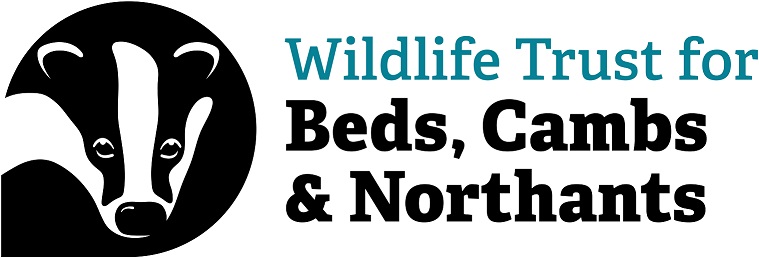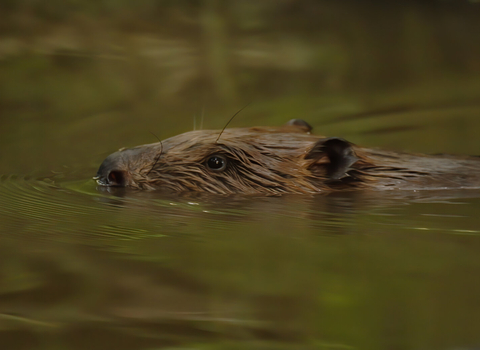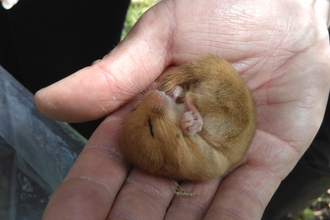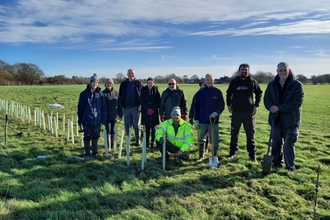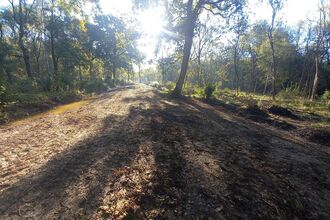As part of the installation work to build our enclosure, we underwent a level of vegetation removal to make way for the fence, as well as opening up an area appropriate for the release day. After cutting, as we usually do, we collected the material and stacked it to one side – leaving it to decay naturally and provide refugia for wildlife. Between February and March, this freshly cut vegetation was a fan favourite of the beavers – with the majority of our camera footage showing them nibbling away at small sticks, twigs, and the odd branch they had pulled victoriously from a pile. Moving homes can be a stressful affair, and as new homeowners will likely attest, turning towards a quick and easy microwavable meal makes sense after you’ve spent all day furnishing your new residence. Low fuss, high efficiency. The beavers responded in kind.
Beaver update - their first spring at Delta Pit
Image by Ben Casey
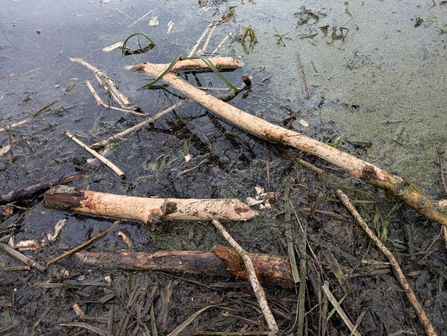
Piles of bark-stripped sticks and twigs such as this were commonplace at Delta Pit between February and March 2025. Image by Ben Casey.
As they developed their lodge, they made use of this easy to come by forage, steadily tasting more and more trees day by day, until eventually they moved on from the small snacks and began trimming the young stems of previously coppiced willow. Over the spring we’ve seen them move on to the main course and begin felling larger trees. Their method has been fascinating to watch – they find an area where they feel comfortable, fell a few trees, then move on to the next hotbed of activity whilst the previous area regenerates.
In our day-to-day management of reserves, we enact a similar process when we create ride side scallops or lay hedges. We’ll find an area which we deem suitable, fell, or coppice a group of trees, and then allow that natural regeneration to occur. Observing these parallels has been quite profound for me personally. We try to emulate nature as best we can, we interpret and replicate, but at the end of the day nothing beats the original. It’s been a great example of how these creatures really are masters of their craft, instinctually finding the balance in creating disturbance to fuel new regeneration. Nature knows best after all.

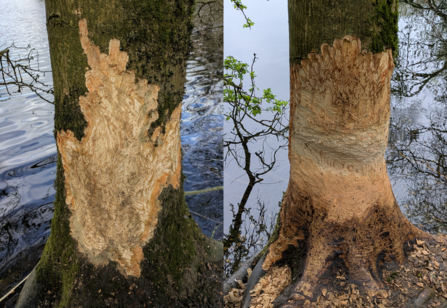
The beavers have steadily been working away at a poplar tree for several months. The image on the left was taken in February 2025, several weeks after the release. The image on the right in April 2025. We’re still awaiting the felling cut! Image by Ben Casey.
We’ve continued to monitor everything else that lives in Delta Pit
Whilst beavers are of course the main attraction, the Nene Wetlands is home to a plethora of invertebrates, mammals, plants, and an internationally significant population of overwintering and breeding birds.
As spring has gotten well underway, so to have our monitoring efforts – which for many species span from April to September. Before our reintroduction, we worked hard to ensure we had the best “before” picture of Delta Pit we could take. To fully appreciate the impact that beavers will have on everything else inside the enclosure, it’s incredibly important to set a baseline from which to compare as we progress through their new management protocols. Now we are in the exciting nascent stages of finding out how other species will react to their impacts, and though previous reintroductions have proven the vast benefits beavers can have on an ecosystem – each iteration is different, and all of this is new for Delta Pit.
Our volunteers underpin everything we do at WTBCN, and monitoring is no exception. The past month has been filled with Julia F’s butterfly transects, Chris and co’s bird surveys, and bat box checking from Gwen and our new Volunteer Officers, Maisie and Michael. Over the coming weeks, John and Kev will be on the hunt for terrestrial and aquatic invertebrates, followed by Julia R’s reptile surveys too. A lot of people give up a lot of their free time to enable us to better understand our environment, as well as communicating this to people in our visitor centre - a big thank you goes out to all involved!
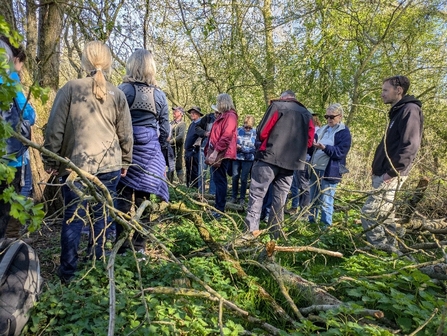
We held a group walk for our visitor centre and reserve volunteers in April 2025 to show what the Delta Pit beavers had been cracking on with. You know you’re on a wildlife wander when everyone stops to stare at a tree for 20 minutes! Image by Viktoria Marta.
Off the back of these surveys, there’s also been some interesting feedback regarding the new fencing. One of the reasons for bringing the beavers into Delta Pit specifically is due to its dense, overgrown, even-aged wet woodland. It’s tricky to get around. Often you’ll find yourself ducking under branches, squeezing between tightly packed trees, or wading through chest high sedge. Thinking back to the early recce walks I took with our fencing contractors, the looks of dismay were palpable as I pointed to where we needed to travel – “You want us to go… there?” – we ventured out and one by one we fell on our backsides at various pitfalls. It’s less painful when there’s so much sedge you can’t feel the ground. Back in the present, the clearance work to facilitate the fencing has provided better access around the site for these surveys to take place. One of our volunteers noted they were able to use the fence line “very successfully” to observe the heronry located on the northern edge without causing disturbance to the birds. Hopefully we’ll have more routes to follow in the future as the beavers unlock new areas of the site, and less falling over as a result.
Our annual monitoring is also being supplemented by novel projects ran by students as part of their master’s dissertations. Shortly after we announced the reintroduction, several bright-minded individuals enquired as to whether they could utilise the enclosure as part of their research. That monitoring has now begun, an excellent example of how enclosures like this can be great sources of novel data – progressing our appreciation of what beavers can bring, as well as supporting young scientists in the process.
The continued engagement with our visitors has been fantastic
The Nene Wetlands is slightly different to any other reserve in Northants in that it is adjacent to a huge shopping complex, Rushden Lakes. The juxtaposition between busy shops and the tranquillity of the reserve is one of the things that makes Nene Wetlands so special. And there’s always something happening! This was certainly the case over the Easter holidays where our Communities and Education team hosted a number of family-friendly beaver events. The “Busy Beavers” days were a particular highlight, where our visitor centre was inundated with enthusiastic children taking it in turns to build the best beaver dam out of sand, twigs, and gravel – all demonstrated through the medium of repurposed plastic guttering. You can’t beat a good hands-on lesson!
Our Comms & Eds team are hard at work preparing more events for the summer months for young people and adults alike, so stay tuned to our website and social media pages for all the latest updates.
Though beavers can now be reintroduced into the wild as part of a new licensing structure set out in February, for our enclosure license agreement, we run biweekly checks of the fence line to ensure the beavers are only affecting Delta Pit. This is always an enjoyable part of the week, both to see how the beavers are getting on, but also because of the conversations I have with people out on the reserve. There hasn’t been a quiet fence check to date, with at least one, but generally five or six groups of people stopping to ask how the beavers are, where they’re likely to see them, and what they’re getting up to. I can answer all three of those questions quite quickly – very well, on the east side, and felling trees. But having the opportunity to go into detail, be enthusiastic, share some facts, and learn some new ones myself is much more enjoyable. It’s great to see that the curiosity of both our visitors and members has surpassed the initial release, and the continued positivity surrounding these creatures is creating more conversations about wildlife, the environment, and the work that we do.
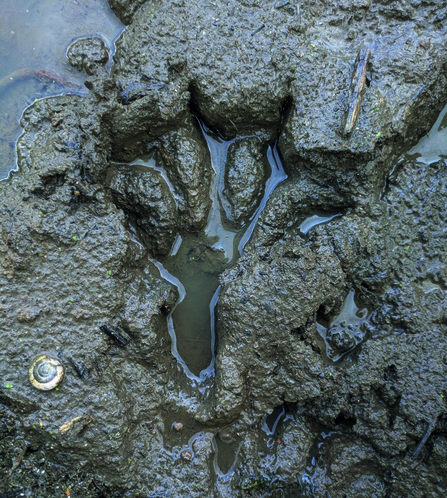
Image by Ben Casey
This spring has been a memorable one so far and looking towards the summer, there’s still a lot of unknowns to keep a close eye on. We’ve found one lodge so far, but will there be more? Will they ever finish felling that huge poplar they’ve been working on for 3 months? Will it ever rain again? Make sure to follow our Project Beaver page to keep up to date.
Here is an update from our trail cameras in Delta Pit of recent beaver activity.
Beaver Trail Cam Update May 2025 (https://www.youtube.com/watch?v=ifs1a_gZVRY)
Thanks to Graf UK for their sponsorship of our Vosker trail cameras.
Lianne de Mello
Wilder Future Fund
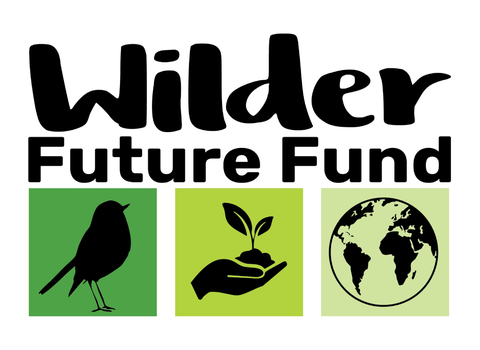
Wilder Future Fund
Our woodlands need you
Woodlands are one of our most evocative habitats. The light, sounds, smells, temperature – everything changes when you walk amongst the trees. They convey a sense of peace and that feeling can have a profound impact on our wellbeing. But we could be in danger of taking their long, rich history for granted; the threats they face today are as great as they have ever been.
Our Wilder Future Fund is an ambitious effort to raise £500,000 a year over the next three years - £1.5 million to help nature recover across our three counties.
With your support, we're already doing so much, but our woodlands are in vital need of more help.
